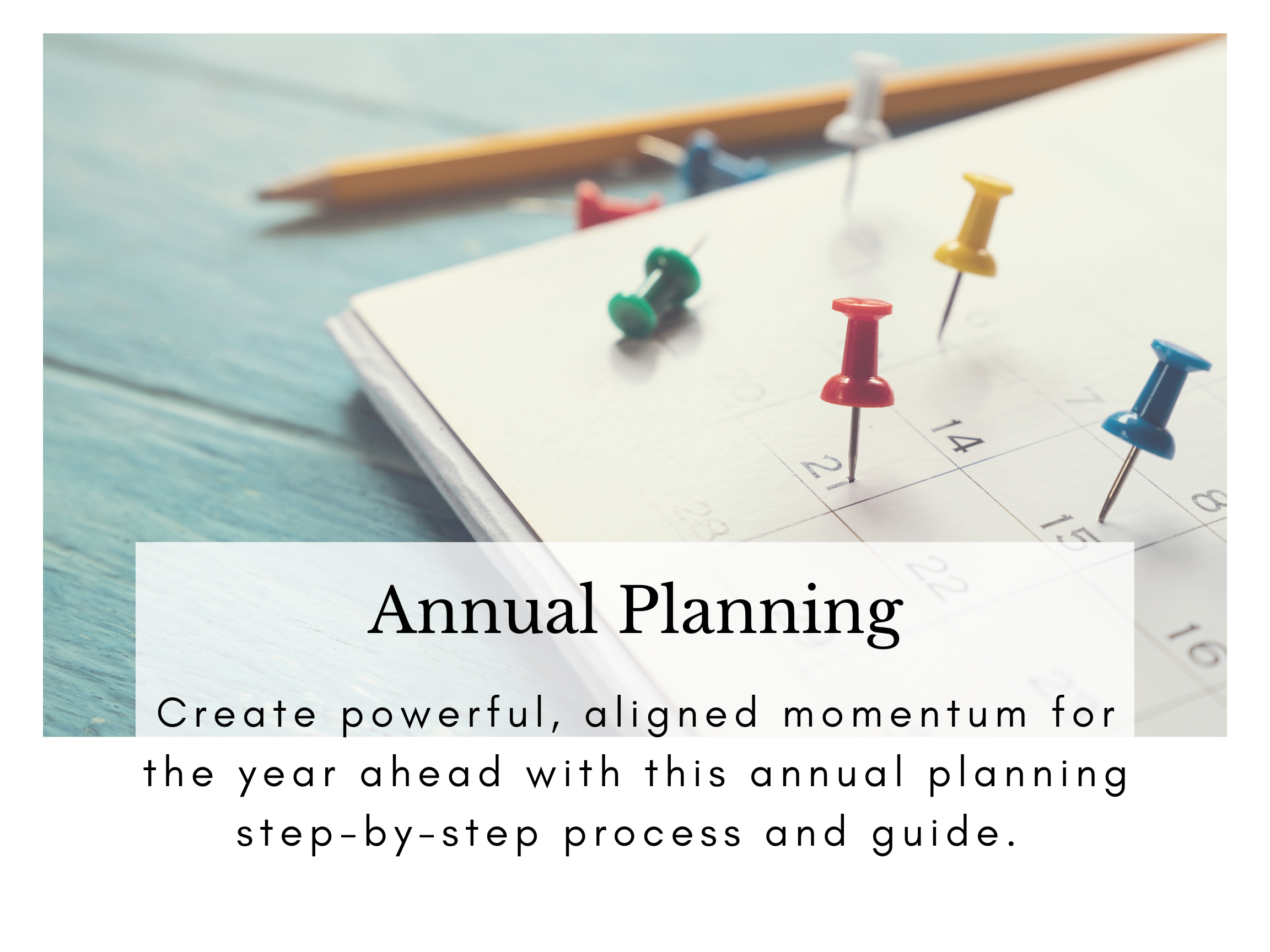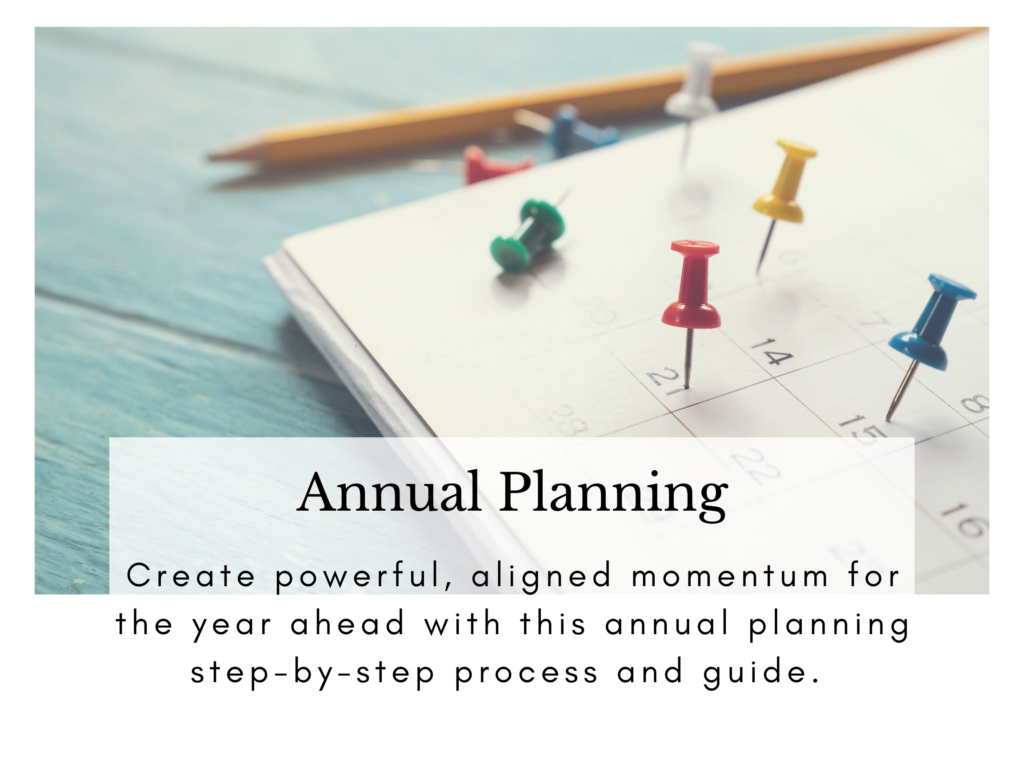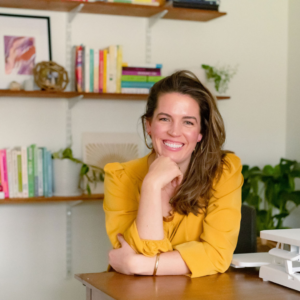

Annual Planning: A how-to guide for you and your partner
Annual Planning: A How To
While there’s a lot baked into this guide, my hope is that it’s a process you can modify and it becomes useful for you and your family.
Any questions, feedback, thoughts, please reach out! dina@myfreewell.com
What you’ll find here:
- First section is “LET’S TALK SOME NEEDED ‘GOOD TO KEEP THESE THINGS IN MIND’ FIRST”. Here are key tips, tricks, things to keep in mind before getting to the actual planning. I strongly recommend going through these to really make this applicable to your life and so as to not set you up for overwhelm. This section alone may provide a lot of conversation/food for thought in how you think about planning, how you set yourself up for it, and how you can think about it with your partner.
- Next is “OVERVIEW & FLOW” – a simple outline of the annual planning process
- Then we break it down and get to work with:
- REFLECTION
- VISUALIZE & BRAINSTOMRING
- PLANNING
- AND THE CALENDAR WORK
I do recommend printing this if you can, step away from the computer and scribble, make notes – make this your own. Good luck!
Also, if you want to print the guide and all this information in a pretty format click the button below!
Annual Planning:
LET’S TALK SOME NEEDED ‘GOOD TO KEEP THESE THINGS IN MIND’ FIRST
I am finding that I want to preface a lot when it comes to putting an annual planning guide together. It’s no wonder, because while I’ve been doing some kind of planning (reflecting back, looking forward, laying out some intentions and steps) on my own since my 20s, and now with Pete (we’ve been married 10 years) it continues to evolve, improve, and even have its pain-points.
But mostly it’s become something we look forward to every year because we love how we feel both individually and as a couple afterwards. Does it solve all the problems, demands and to-dos? Of course not, but it’s a great reset and huge step forward on gaining positive momentum that is aligned to our vision and values personally, professionally, and as a family unit.
Here’s what I want to emphasize, make this your own – over time.
If this is a new process to you, and or your partner, ease in. Remember, when you’re interested in adapting or integrating a process or new habit you’re intrigued with – always consider questions on how you can modify it to make sense for you, your life, your relationship, your family.
If I were working with you on a coaching level we would talk a lot about this – in fact, I may not even bring up the annual planning until later, or maybe I’d bring up a few points depending on where you’re at this season of life, what the key needs are right this second, your capacity, your support, your struggles. I might start instead with the weekly chat guidance which is a huge game changer when it comes to the daily time management, invisible labor, more immediate needs as an individual, couple, and family.
All that to say, I’m going to bullet-point some key considerations, tips, and thoughts I would STRONGLY suggest you read through first before getting to the planning guide flow and questions.
- Especially if this is new, give yourself and your partner time with this process and the questions. You don’t have to go all in right from the beginning, and you definitely don’t have to do it all in one sitting.
- Importance of open listening, especially when it comes to the Reflection questions and listening to your partner. Chances are, depending on the mood you are each in, what happened today or in the past week, you’re not in the exact same place mentally/emotionally/physically (and are you ever really?).
- Be open as you listen and as they may take this process differently than you. You might recall different things, they may leave out things you thought were important — it’s all OK. Just listen to each other, focus on that, and focus on your answers and how you’re processing everything not critiquing.
- Open listening (not noticing/bringing attention to differences/holes/critiquing/fixing) will be key to you both getting as much out of this as you can, and understanding each other’s perspectives while enhancing your own sense of being heard and growing (both individually and in a relationship).
Timing & Location (it’s about being in the right frame of mind!). This could be a whole discussion, seriously, and I will tell you it is one of the most important considerations in this process is figuring out what is that right formula where you and your partner can focus, be inspired by, connect, have a little play, and relax. And mind you this CAN happen at home – and we’ve done it plenty of times. The key is to try to integrate, as much as you can, some of those elements that you could get in a getaway into your “at home experience”.
- When I was a research and innovation consultant for mega brands anytime we would start planning an ideation for a team – the time, place, and what’s around were so critical to the process. We knew we would be asking a lot of the team members attending as we’d be guiding them through various creative strategies, insights data, ideation tools to help them innovate or strategically plan next steps for their brand. Having the right agenda and place to help make that creative magic flow was key and it’s the same for this process!
- In a in a perfect world where resources, childcare, and time were of no concern I would tell you and your partner to pick a place to get away for a weekend that’s not too far (1-2 hours driving) so that you can experience and integrate at key times:
-
-
- a buffer or time to begin that shift into what you’ll be doing like a drive with a podcast to help you both connect, discuss, get in the mood of what you’re about to do
-
- a place that is both quiet and equally inspiring to be in with minimized demands or distractions (dishes, laundry, family calendars on the wall, work in the office) — so that you can focus, and has beautiful inspiring art/landscapes of the outdoors/whatever those things are that will visually inspire you subconsciously and consciously
-
-
-
-
- for us this is a state park lodge with restaurant and hiking all on the same grounds, or an Airbnb spot close to hiking and at least one place we like to eat at
- the times we’ve planned at home, we had to arrange for childcare so they’d be out of the house which can be tricky especially if you have older kids teen age. It might be that you arrange with a friend or neighbor blocks of time your kids will be out so you can concentrate.
- It’s great if you can get out of your normal surroundings and demands and if you need to be at home even think about how to minimize the demands and distractions around you. For instance, we planned this past year at home, it wasn’t all as smooth as it could be partly because River our dog was his needy, lovable self but during that time it was a big distraction that turned to annoyance and a waste of time trying to accommodate him. Hindsight we wished we had gotten a dog sitter for a day or even tried to keep him crated more.
-
-
-
-
- play and not making it all work – it’s great if there are things around where you’re going to plan where you can break a bit and play and or walk and continue talking about some of the discussion points. We are asking a lot of our brains with this, and some of the questions and their responses can be emotional (both good and harder emotions) so providing those opportunities to break and play.
- when Pete and I stay at the lodge, there are ping pong tables, the pool, hiking …things we can go do while still continuing to discuss if we feel up for it or just have some fun and give our brains a break.
- play and not making it all work – it’s great if there are things around where you’re going to plan where you can break a bit and play and or walk and continue talking about some of the discussion points. We are asking a lot of our brains with this, and some of the questions and their responses can be emotional (both good and harder emotions) so providing those opportunities to break and play.
-
- if we’re planning at home or in town, we add in walks, going to a coffee shop or cafe we never go to together that has couches and big windows where we can work for a bit and be inspired by the new place, maybe just step out for lunch break, do a workout or hike
Keep notes and process points in a document you can refer back to, evolve with, and repurpose.
- I love the actual brainstorming and reflecting to happen on paper and away from the computers (hello distraction). But when you get to the planning part, it’s ok to start inputting into a Google doc or some place you both have access to and can update, track, and move forward with. For us this is a google doc which makes it easy to track responses, and then copy and past to repurpose/add onto/modify year after year.
- Take this guide, copy and paste into a document of your choice and let it grow with you.
Brainstorm, make notes, reflect and visualize first individually in your own corners, then come together to share and continue planning.
- There’s a lot of benefit to allowing 30 to 60 minutes to sit individually with whatever questions/flow you decide to focus on and make your own notes then come together to discuss and continue. Discuss briefly as a couple what you want to focus on, align on that, then decide how much time you want to give each other to work individually before coming back together.
- When you come together, I’d recommend going point by point each sharing what you had for that one then moving on and remember to practice open listening:
- Prepare to share stories by finding a quiet place and face each other. Ask your partner about his/her experience. Give your partner time to express him/herself.
- Do not interrupt, you will both get a chance to share.
- Avoid sighing, shifting weight in reaction.
- Suspend your own story and own version and really hear your partner’s point of view.
- When one person is done speaking trade roles.
- (once you’ve listened to that point you can consider asking questions to deeper connect/understand):
-
- How was thinking about that for you? What was easy/hard for you?
- Anything surprising?
- What are you needing? What comes to mind?
- How can I help you better?
- How do you think we can help each other more?
-
Timing: like I said, if you can plan a day (ideal would be a weekend) awesome however that’s not always possible. So keys are:
- Do this kind of reflecting/process/planning when you’re both more fresh (think morning and day, not end of day when you’re both exhausted).
- Adjust schedule and pace at which you go through things if someone is not feeling well / sick. We’ve had this happen before and tried to keep the same schedule as if we were both great, and it was hard. The person who was getting sick just felt worn out and more stressed in the dreaming, it wasn’t as fun and they weren’t in the right frame of mind.
Vision & Values To This Process. This guide focuses on the flow for annual planning and key questions, prompts to begin laying out details to help you create some momentum for the year ahead. However, having a personal vision and values that you can put all this planning against is a huge benefit. I work closely with individuals, teams, and businesses on outlining a vision and values but this guide does not focus on that process extensively. I want to call that out. If you have these great, use them with the process. If you do not, consider briefly outlining some and if you want help – reach out. Having these are key to less stress, less comparison, less kicking yourself for not living how you truly envision living and more doing the things and reaching the places you want to go!
Let’s get to the flow and key questions!
Annual Planning:
OVERVIEW & FLOW
The basic flow for some annual planning is to:
- Reflect on the past year and your values
- Brainstorm and visualize the future – key things you want to get done this year (knowing of course it can evolve)
- Plan – this is more the nitty gritty, getting steps down, new habit changes, key dates
Within each of these sections I will outline key questions and prompts to consider.
Annual Planning:
REFLECTION
What’s been the best for you this past year? What were the highlights? List the ones that come to mind. Remember, highlights can be little or big, professional, personal, etc.
- After you have some listed out, go back to photos and begin at the beginning of last year, scroll through and make note of any other highlights you may have not listed above
What has been most difficult for you this past year? What could’ve been better? Were there areas of life, demands, that were especially challenging to you this year or even a part of the year?
What did you like doing together this year:
-
- individually?
- as a couple?
- as a family?
Financial reflection:
- In the past year, in what areas did you spend more money than expected? Was it intentional?
- If you are married, what does each spouse think about the level of spending last year?
- Are there any expenditures that you know did not bring you happiness, express your values, or provide peace of mind?
Annual Planning:
VISUALIZE & BRAINSTORMING
What do you want to do together this year? What is our intention/goals for our relationship this coming year?
What do you want to do with the kids this year?
Financial visualization and brainstorming:
- If someone forced you to spend less money in one area, what would it be?
- If someone forced you to spend more money in one area, what would it be?
REFLECT, VISUALIZE, BEGIN PLANNING
Now go deeper into the categories below exploring what were highs and lows of each, and 1 key intention, thing you’d like to put effort towards doing in the coming year. Here you are really thinking big picture highs, lows, and beginning to shift into more what to do next.
- Health/physical/vitality
- Vocational/career/work/school
- Financial/money
- Family/love life/children/extended family
- Social connections/friendships
- Feeling grounded/connected/spirituality
- Mental/purpose/vision
- Play/joy/fun/creativity
Annual Planning:
PLANNING
Consider your brainstorming and visualizing up to this point. At the level you want to produce at, what are some things you/we can do to make that possible AND sustainable? (both at home and work)
What can be simplified in our lives (work, home, relationship, other)? Where can we lighten more in our lives?
TALKING CALENDAR & BLOCKING KEY DATES, THINGS WE WANT TO DO
This can be a fun time if framed right! Get your calendars/computers out and start blocking. This step is critical to creating some momentum for your year ahead. As you figure out what works best for you and your partner, you may get to a point you even want to begin booking the travel (flight, lodging, etc) during this step.
Pete and I have gotten to a place that this step alone gives us a lot of peace of mind especially since we both own our businesses and if we don’t block the time now — it’s REALLY HARD to make it happen as the year gets in progress and clients are booking, and kid activities are in full swing.
One of the best things that’s come out of this calendar talk has been we’ve tried new things and established traditions centered around experiences as a family that have become more plug and play in planning.
Since we’ve gotten into the habit of doing it each year, now we have a process (i.e. every October during peak fall foliage we take a cabin trip, or last year we knew we wanted to try a new thing in the summer and take a random Tuesday to surprise the kids with a Kings Island amusement park outing).
Every year we’ve gotten better about identifying what those experiences are we want to do in the year ahead, and we have learned to prioritize, expect, and look forward to those key trips/family traditions
Ask yourself what could it look like (and feel like) if you left the calendar blocking time with:
- all our holidays and time we plan to ask off/block off is done?
- vacations and small breaks like spring break time was blocked so you can begin planning?
- perhaps there are certain things you can do now in addition to blocking the calendar, to keep the momentum going (i.e. book flights, get the car rented, book a place to stay, start a google doc with a few places to check back on, schedule time to plan the trip you have blocked on the calendar in another week)
Next I’m going to outline what those key things are we discuss and block, and even get to some booking/planning details for some of them. Decide what those things are for you and create your list.
CALENDAR & BLOCKING KEY DATES, THINGS WE WANT TO DO
First you‘ll think high-level on key things you know/may want to do, next step you‘ll go month by month through the calendar and get more granular.
- Block holiday time off on work/personal calendars
- Birthdays (mark all birthday parties tentatively – it can always change but having that date blocked helps)
- Recurring family traditions/trips, block the times. This is an area where if you have recurring things you do every year (i.e. Pete, his brother and dad see a ND football game every year) you can make note of them, schedule the time or at least narrow a few time options and check with involved parties to solidify.
- Summer Camp considerations for kids: do a quick search on key camps you might want to consider and when live registration starts (many of them start in the late winter/early spring for summer camp signup). I keep a google doc “summer camp” and track info about each there.
- Experiences/trips we might want to prioritize and potential months they could happen (remember, this could be an experience like a date/few hours to a weekend thing to a longer vacation-type experience) – these are just ideas below:
- time with friends solo and or together as a couple
- spring break
- fall rejuvenation/shift
- solo time/trip
- family vacation(s)
- summer joy list plans
- a couple’s weekend away
- annual planning weekend for next year
- concerts/art performances we want to see (check spring/summer/fall/winter calendars)
- holiday events/traditions we want to prioritize
- key school events blocked on work calendar (i.e. daddy daughter dance, end of year party to volunteer at, etc)
- People (friends/family) Visiting Us: if you know these dates great, or if you want to outline a few invites/encourage friends/family you’d love to see them, get the ball rolling.
CALENDAR & BLOCKING KEY DATES, THINGS WE WANT TO DO
For us, we get our calendars out (paper and Google calendars) and we create invites and block out each of these. For some that involve other folks (like family parties, family trips/traditions) we invite those people on the invite so everyone is awa o of those dates and less talking back and forth about them later.
Next, go month by month and begin charting the things you want to prioritize/plan/block within each month.
Helpful Tip: ***mark in color once event/trip/experience is booked. OR you’ve set a reminder to book it/plan/register in your calendar. Basically mark it “off” below by highlighting it, which says I’ve put it in my calendar and won’t forget about it now.
JANUARY
FEBRUARY
MARCH
APRIL
MAY
JUNE
JULY
AUGUST
SEPTEMBER
OCTOBER
NOVEMBER
DECEMBER
To Download the Printable Guide click here!
If you have any questions/thoughts/ideas you can simply comment below or contact me.
Here’s to alignment that creates growth, and those forever-felt ripple effects,
Dina

Are you new here? Welcome!
Hi, I’m Dina, thanks for being here and I hope this was helpful for you! I am an independent coach, consultant and ethnographer by training – strategic thinker, adept connector, with an insatiable curiosity and commitment to learn.
I have 16 years of experience spanning consulting, market and behavioral research, facilitation, coaching, brand and innovation work with a variety of clients from one-on-one, small teams and businesses, to Fortune 500 companies like Procter & Gamble, Gap Inc, & Kraft.
My coaching approach is integrative and combines behavioral and org science with innovation, branding, and holistic practices. Today, along with my husband, I own and operate two small businesses. I hold a Master’s in Organizational Diagnosis & Intervention and behavioral study, am a Certified Five Capitals Business & Leadership Coach, and a Certified Integrative Health and Nutrition Coach.
- I offer individual and group coaching – both virtually (be anywhere) and in-person for the local Cincinnati. More about me here and services offered.
- My email, The Aligned Life, goes out once or twice a month. If interested, subscribe here.
- Connect with me on Instagram, LinkedIn but the best place to connect if you like more intimacy is via my Aligned Life email, here I love having the best conversations and connections (next best thing to meeting in person).



